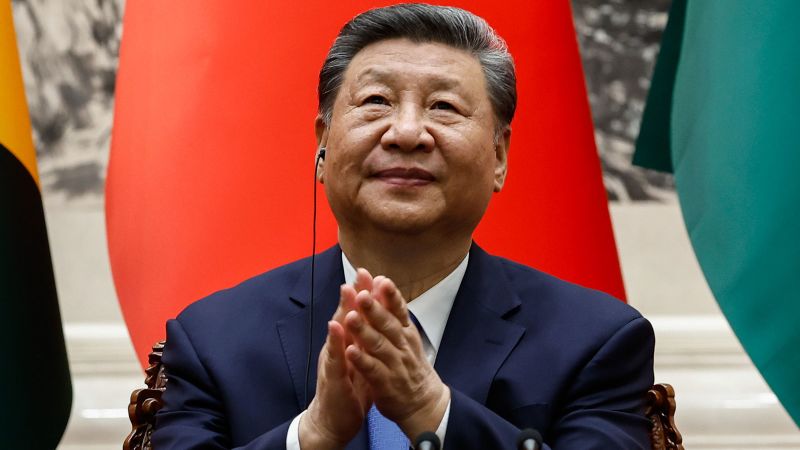President Donald Trump is currently engaged in a high-stakes strategy aimed at confronting China, the second-largest economy in the world, with the hope that this audacious approach will eventually benefit the United States. This outstanding gambit, however, comes with uncertainties regarding its long-term outcomes. In recent months, Trump has experienced a notable winning streak. The US stock market is nearing historical highs, the economy showed a robust rebound in the second quarter, and inflation has not escalated as many had predicted following the implementation of tariffs.
Nonetheless, Chinese President Xi Jinping appears to have his own winning streak. Recently, Trump signaled a willingness to expedite the delivery of advanced artificial intelligence (AI) chips to China, partly easing restrictions that previously hindered their trade. Additionally, despite the tariffs imposed by the United States, China has successfully sought alternative markets to offset potential economic repercussions, rapidly increasing its goods’ availability worldwide.
Xi Jinping wields several crucial advantages in this ongoing contest. China stands as the foremost exporter globally, which grants it considerable leverage on the international stage. Moreover, China controls a predominant share of the world’s supply of critical rare-earth minerals necessary for electronics and defense equipment, which are integral to US national security. Xi has cautiously navigated the export of these minerals, much to the frustration of US authorities.
In a key element of their strategic competition, President Trump has taken a hardline stance against China, escalating tariffs that began during his first term and have continued under his predecessor, President Joe Biden. Early in his second term, tariffs on Chinese imports were set at no less than 20%, with rates rising to as high as 145% by spring. Although negotiators from both countries managed to reduce tariffs to 30% in May, this figure is still historically high and reflects a level of pressure on US companies that rely heavily on Chinese imports.
Despite these tensions, Trump has reported minor victories in negotiations, such as commitments from China to purchase US soybeans and an end to antitrust inquiries into several significant American firms operating in China. While these results may not seem transformative, they have contributed to substantial tariff revenue being generated for the US Treasury, and inflation levels have remained relatively stable even after earlier forecasts suggested otherwise.
During the last quarter, the gross domestic product (GDP) of the United States reflected a significant growth rebound, though it came with warnings about slowing jobs growth. The job market’s expansion has tempered somewhat, yet some economists predict that the easing tensions around tariffs could lead businesses to begin hiring again imminently. Simultaneously, the stock market, a favorite gauge of success for President Trump, has thrived largely behind strong corporate earnings and speculations surrounding imminent rate cuts by the Federal Reserve.
While he continues to describe China as a national security threat and economic adversary, Trump has approached Xi with a degree of diplomacy that contrasts sharply with his treatment of other global allies. This consideration arises from Xi’s considerable bargaining power, particularly due to China’s dominance in rare-earth mineral production. The US relies heavily on these materials for crucial industries, but China currently oversees about 90% of the global processing capacity for rare-earth elements.
China has recently sought concessions from the US, particularly aimed at lessening export controls on vital technology, especially advanced AI chips. In a surprising pivot, during negotiations earlier in the week, Trump expressed a willingness to allow Nvidia’s H20 chips, which are integral to Chinese technological advances, to make their way into the Chinese market. This shift marks a significant change from previous firm stances that refused such exports outright.
China’s economy has proven resilient, cleverly adapting by expanding its market reach to regions across South America and Africa, thereby maintaining stability amidst the trade tensions with the US. According to recent reports, Chinese exports increased by 5.9% during the early part of 2025, matching growth rates of the previous year, while a record trade surplus was recorded.
Another area Trump seeks is a meeting with Xi—historically a pivotal moment in US-China relations. Although Trump has claimed to have secured a promise from Xi regarding a face-to-face discussion, confirmation remains elusive from the Chinese side.
In summary, as both leaders navigate this intricate web of negotiations and posturing, Xi holds substantial cards against Trump’s aggressive tariff policies. This dynamic represents a challenging landscape for the US president, who has effectively used tariffs as a tool against numerous foreign leaders, but finds himself in a complex competition with China, where strategic resources, trade channels, and diplomatic meetings are all pivotal in determining the outcome of their interactions.











